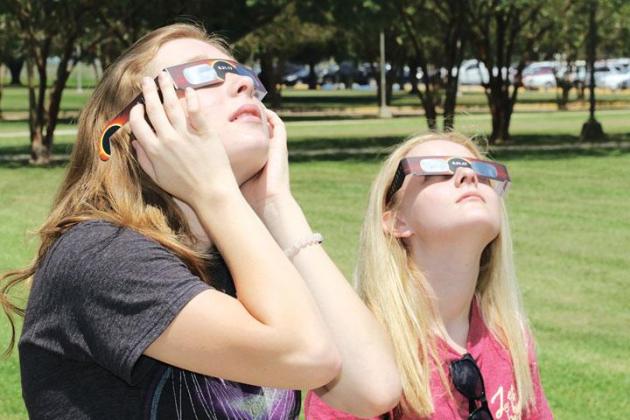
Harlan Kirgan
Even a partial solar eclipse creates its own brand of excitement as evidenced by the reaction to it on Monday at LSUE.
Near the Acadian Center, an area was situated with a large-looking telescope, pinhole boxes, viewing glasses and some pretty curious and excited people.
Dr. John Hamlin, head of the Division of Sciences and Mathematics, said, “It is one of those things you only see once or twice in your lifetime and it would be a shame to miss. If we live to 2024 we might get a second shot. That will be it for me,” he said.
The telescope did not get set up in time for the partial eclipse that began at 11:51 a.m. and ended at 2:51 p.m. The partial eclipse reached its maximum stage at 1:23 p.m. About 73 percent of the sun was covered by the moon.
The eclipse made its presence known by throwing its image onto the ground in burst of crescents cast through leaves.
Ashlynn Tate, a University of Lafayette Louisiana student, said, “I’ve been waiting to see this since I was a sixth-grader. I’ve been interested in astronomy, so, it’s petty exciting.”
LSUE student Lacie Kidder said the eclipse is what she expected it to be.
Christopher Reed, an LSUE freshman, seemed to be the vocal expert on the scene as he called out how many minutes it would be until the eclipse reached its maximum stage.
Dr. Avery Williams, a biology professor, said, “It’s neat. It’s neat,” when asked for his reaction to eclipse.
“It has kind of has a darker tint to everything. Did you see the shadows on the ground?” he asked.
Math instructor Gloria Martel said she first saw an eclipse in 1984 in New Orleans during the World’s Fair and it turned dark then.
“I like all the patterns in the leaves,” she said.
The eclipse was total for a swath of the United States. The “Great American Eclipse” began at 9:06 a.m. PDT in Oregon and ended at 4:06 p.m. EDT in South Carolina. The last total solar eclipse occurred on Feb.26, 1979, and the next one is on April 8, 2024.
As for any drop in temperature due to the partial eclipse, Hamlin, noted, “It is still hot” as the celestial event unfolded.
